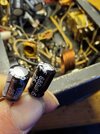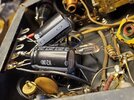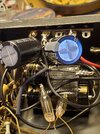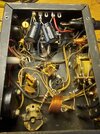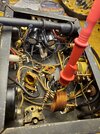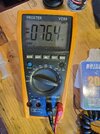I told ya all I would send some photos so I am and glad as I had to make some adjustments as the first caps I used were apparently to small and I wasn't for sure on the rule of thumb for the doubler but I originally had a couple 680uf 25v caps on the doubler because I had a bunch around but knew to keep a eye on them and looks like they were starting to bulge on the ends so I replaced them with 2200uf 35v caps, hopefully these will work out OK? Anyways the little modulator is working great I did not route the screen voltage to the relay but I have done that to many of my JB150 and I may do it to this one when and if I replace the relay later.
You are using an out of date browser. It may not display this or other websites correctly.
You should upgrade or use an alternative browser.
You should upgrade or use an alternative browser.
-
You can now help support WorldwideDX when you shop on Amazon at no additional cost to you! Simply follow this Shop on Amazon link first and a portion of any purchase is sent to WorldwideDX to help with site costs.
Wawasee style JB12 " no bias components"
- Thread starter Danzik
- Start date
Indeed !Rock on!
Congratulations. Gotta love it when a plan comes together.
73
Notice the size of that replacement plate transformer. That seems robust for a 6BQ5. It looks big enough to run two 6LF6s. Heavy duty.I got her rocking fellas ! I have -69 VDC of bias now ! Thank you ! I will post more pics later, it is working great !View attachment 70591
Yeah, I kinda noticed the same, it puts out more than the average JB12 however I think it's going to run just fine without destroying tubesNotice the size of that replacement plate transformer. That seems robust for a 6BQ5. It looks big enough to run two 6LF6s. Heavy duty.
Keep in mind, in the absence of bias switching, that tube is biased in the transmit mode all of the time. Check to make sure it is not developing excessive heat in the receive mode, otherwise that tube is not going to last long. The good news is, these amplifiers operate close to class C so, there is not much idling current flowing.I told ya all I would send some photos so I am and glad as I had to make some adjustments as the first caps I used were apparently to small and I wasn't for sure on the rule of thumb for the doubler but I originally had a couple 680uf 25v caps on the doubler because I had a bunch around but knew to keep a eye on them and looks like they were starting to bulge on the ends so I replaced them with 2200uf 35v caps, hopefully these will work out OK? Anyways the little modulator is working great I did not route the screen voltage to the relay but I have done that to many of my JB150 and I may do it to this one when and if I replace the relay later.
The determining factor will be if the tube's anode turns red during use. If it does, it's being hit too hard.Yeah, I kinda noticed the same, it puts out more than the average JB12 however I think it's going to run just fine without destroying tubes
The underlying intent of a "Jewel Box" amplifier is to bias the tube beyond cutoff. Serves to attenuate the carrier and exaggerate the modulation envelope. So long as the tube is biased to cutoff, theory says you shouldn't need to shut down the screen. We do it anyway. Get a tube hot enough and cutoff bias may or may not keep it under control when you unkey.
73
73
Last night I tried a 3 prong relay like what is in the Robyn radios and whatnot but it didn't likeKeep in mind, in the absence of bias switching, that tube is biased in the transmit mode all of the time. Check to make sure it is not developing excessive heat in the receive mode, otherwise that tube is not going to last long. The good news is, these amplifiers operate close to class C so, there is not much idling current flowing.
The tube as of right now has -70 vdc of bias, seems to be doing great but haven't used it alot yet but will keep a eye on that 6BQ5The underlying intent of a "Jewel Box" amplifier is to bias the tube beyond cutoff. Serves to attenuate the carrier and exaggerate the modulation envelope. So long as the tube is biased to cutoff, theory says you shouldn't need to shut down the screen. We do it anyway. Get a tube hot enough and cutoff bias may or may not keep it under control when you unkey.
73
The difference is likely to be the coil voltage. This amplifier only has 6 volts available for low voltage.Last night I tried a 3 prong relay like what is in the Robyn radios and whatnot but it didn't like
The tube as of right now has -70 vdc of bias, seems to be doing great but haven't used it alot yet but will keep a eye on that 6BQ5
Wawasee used two kinds of relay. The older version has a skinny 6AQ5A tube alongside the larger tube. This tube senses the radio's RF and energizes the relay's coil. This version uses a relay with a 10,000 or 9000-ohm coil, meant for 100 or 110 Volts DC. NOT AC! There's a difference in construction, and the 120-Volt AC relay just won't work.
Later versions used a transistor to sense the radio's RF and activate a relay with a 12-Volt DC coil.
Only a relay with a coil matching the particular amplifier works, Can't substitute one for the other.
73
Later versions used a transistor to sense the radio's RF and activate a relay with a 12-Volt DC coil.
Only a relay with a coil matching the particular amplifier works, Can't substitute one for the other.
73
Oh wow! I completely overlooked the fact that this is an older unit with the 6AQ5 tube. That will not be an easy relay to replace. Later versions only had 6.6 volts of AC to work with from the filament winding.Wawasee used two kinds of relay. The older version has a skinny 6AQ5A tube alongside the larger tube. This tube senses the radio's RF and energizes the relay's coil. This version uses a relay with a 10,000 or 9000-ohm coil, meant for 100 or 110 Volts DC. NOT AC! There's a difference in construction, and the 120-Volt AC relay just won't work.
Later versions used a transistor to sense the radio's RF and activate a relay with a 12-Volt DC coil.
Only a relay with a coil matching the particular amplifier works, Can't substitute one for the other.
73
That often relates to an unregulated screen supply where secondary emissions are driving the screen voltage higher. Using a low impedance screen supply or the addition of a shunt regulator, keeps tetrodes much more stable over wider operating conditions and temperature.Get a tube hot enough and cutoff bias may or may not keep it under control when you unkey.
73
Prior to adding the zener diode and the NPN power transistor on a little heat sink, my unit would not maintain a stable output power. It would creep up the longer you were keyed and made using it as an exciter, almost impossible.
Last edited:
Normally I would agree, but there are two fleabay dealers listing that part.That will not be an easy relay to replace.
https://www.ebay.com/itm/2027295389...pid=5336136228&customid=&toolid=10001&mkevt=1
https://www.ebay.com/itm/1736318452...pid=5336136228&customid=&toolid=10001&mkevt=1
No telling how long before either one sells out.
73
That is the one I tried Nomadradio and all it wanted to do was chatter, didn't work well unless I cranked up the deadkeyNormally I would agree, but there are two fleabay dealers listing that part.
https://www.ebay.com/itm/2027295389...pid=5336136228&customid=&toolid=10001&mkevt=1
https://www.ebay.com/itm/1736318452...pid=5336136228&customid=&toolid=10001&mkevt=1
No telling how long before either one sells out.
73



